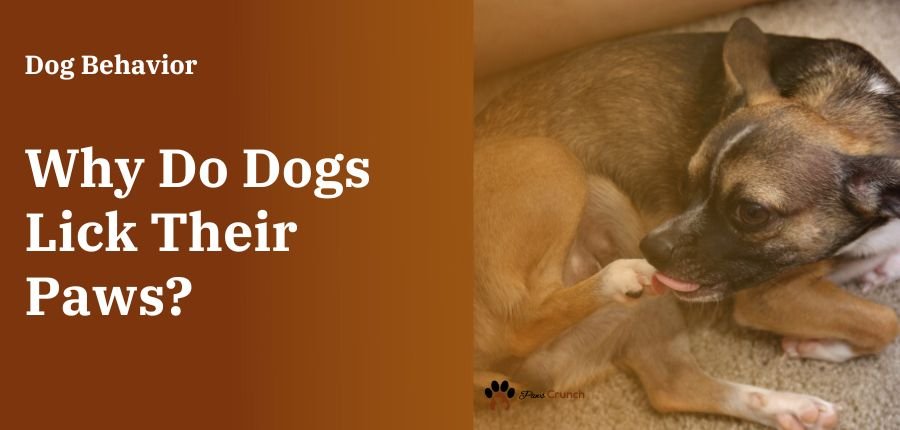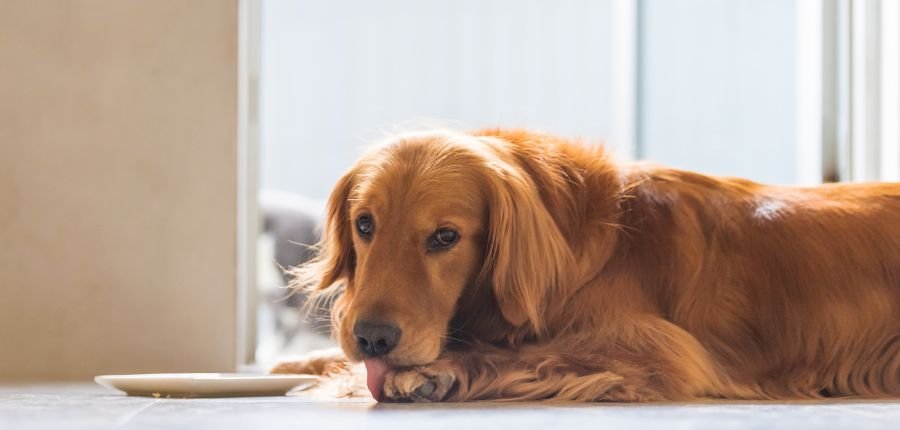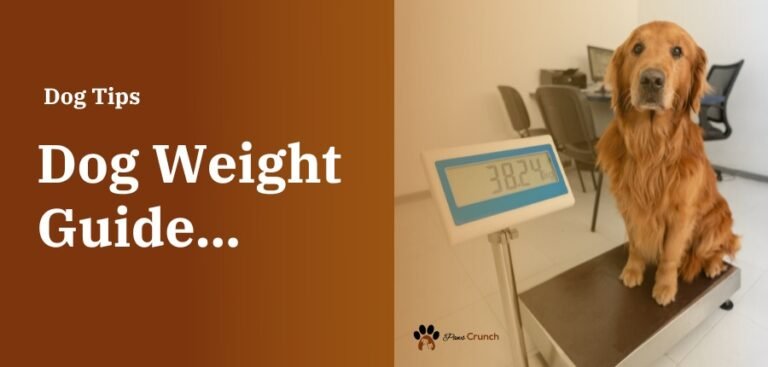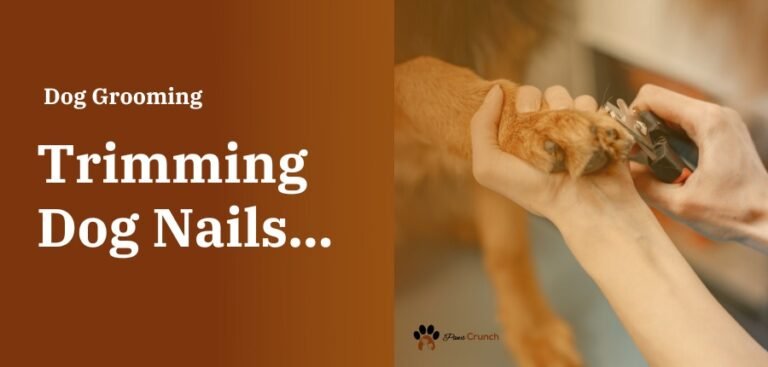Why Do Dogs Lick Their Paws?
Our dogs captivate us with their silly antics and endearing personality quirks. One common behavior we often catch dogs doing is licking their paws incessantly. Have you ever wondered why do dogs lick their paws?
The reasons are plentiful. Paw licking serves purposes like grooming, calming, and alleviating discomfort. But it can also signal underlying issues like allergies, anxiety, or illness requiring veterinary attention.
This article will look at the science behind why dogs lick their paws and provide actionable solutions to curb unhealthy licking habits. You will get insights and advice to help you comprehend and enhance your dog’s compulsive paw licking tendencies.
Why Do Dogs Lick Their Paws – Main Reasons

I have compiled a list of the top 7 reasons for dogs lick their paws below:
Grooming
Dogs lick their paws to clean themselves, which is one of the most common reasons. Licking maintains a natural layer of moisture on the paw pads and removes dirt or debris caught between the toes or foot pads. This is a normal self-grooming behavior for dogs.
Mother canines engage in licking their recently born puppies, primarily to maintain hygiene and promote bowel movements and urination in the little ones.
As puppies develop and grow, they naturally adopt self-licking behaviors, imitating the grooming actions learned from their mother. This self-licking behavior continues as an instinctual grooming mechanism for adult dogs.
Licking keeps a dog’s paws clean for health reasons. Dirt, mud, bacteria, parasites, and dampness trapped between the paw pads or toes can cause infections if left untreated.
A natural lick provides moisture and a little scrubbing action to prevent the buildup of unwanted paw grime. So, in moderation, paw licking is likely just Fido keeping his feet fresh and tidy.
Calming Signal
Licking paws may also provide a calming effect for anxious or stressed dogs. Grooming releases feel-good endorphins that help relax a dog.
Some dogs will rhythmically lick their paws or fur when crated, left alone, during fireworks, or in other situations that make them nervous or upset. It serves as a self-soothing mechanism.
Licking also signals to other dogs that they are not a threat. Yawning, sniffing, sneezing, and paw licking are all considered calming signals that communicate friendly intentions in the canine world.
So when you notice paw licking in social settings, your dog may simply be communicating to other dogs to convey that things are cool. This helps avoid confrontations or aggression between dogs.
Itching and Allergies


Sometimes, dogs excessively lick their paws because they itch. Itching leads to more licking in an attempt to relieve irritation. This can signal an allergic reaction to something in the dog’s environment or diet.
Environmental Allergies
Dogs can develop allergic reactions to things they inhale, like pollen, dust mites, and mold. The allergens in these airborne particles cause itchiness on the skin and paws. Dogs may lick, bite, or chew their paws in an effort to make them stop itching.
Environmental allergies in dogs are usually seasonal and correspond with peak pollen counts in spring, summer, and fall. Licking when exposed to grasses, weeds, and trees is the most obvious sign of outdoor allergies.
Food Allergies
Allergies to ingredients in dog food can also cause itchy, irritated paws. The most common food allergens for dogs include beef, dairy, chicken, lamb, fish, eggs, corn, wheat, and soy.
If your dog seems to constantly lick his paws, switching to a limited ingredient dog food made with a novel protein source may help. Venison, kangaroo, bison, and duck are less likely to cause allergic reactions.
Flea Allergy Dermatitis
Even a single flea bite can trigger intense itching and discomfort in dogs with flea allergies. The saliva from flea bites causes a skin reaction, leading to licking, chewing, scooting, and scratching.
Check your dog’s paws carefully for signs of fleas if licking corresponds with flea season in your area. Use monthly flea and tick preventatives prescribed by your veterinarian to keep fleas off your dog.
Infections
Sometimes, paw licking indicates a bacterial or yeast infection between the paw pads or toes. Damp fur between the toes from licking creates the perfect environment for infection to brew. Paw infections cause swelling, redness, an odor, and itchiness, prompting more licking, which exacerbates the problem.
Common paw infections include:
- Yeast infections like malassezia
- Bacterial infections like staphylococcus
- Fungal infections like aspergillus
Paw infections require medication prescribed by your vet to clear them up. Keeping your dog’s paws clean and dry can help prevent recurring infections.
Injury
If your dog is suddenly licking at one specific paw more than usual, check it carefully for injuries. Limping or licking localized to one paw or leg warrants closer inspection.
Look for puncture wounds, torn nails, splinters, burns, foreign objects stuck in the paw pads, bee stings, spider bites, or chemical irritants like lawn chemicals or road salt.
Licking is your dog’s way of trying to cleanse and soothe injured paws. However, excessive licking can lead to more swelling and delayed healing. Veterinary attention is required to properly clean, medicate, and bandage wounded paws.
Sores and Interdigital Cysts
Chronic paw licking can create moist, raw sores called interdigital cysts between a dog’s toes. The friction of licking wears down the hair and irritates the skin over time. This can allow secondary infections to develop.
Interdigital cysts are painful and cause a dog to lick and bite their paws more to try to reduce the discomfort. But this only worsens the problem.
See your vet for medication to resolve the infections and itching, as well as recommendations for preventing recurrence.
Anxiety and Boredom
In some cases, paw licking stems from psychological issues like anxiety, boredom, loneliness, or compulsion. These dogs usually lick their paws excessively for long periods of time rather than brief grooming.
Dogs suffering from separation anxiety may lick themselves when left alone as a nervous outlet for stress. Providing puzzle toys when you’re away and maintaining a predictable routine can help ease anxiety.
Bored dogs confined for long periods in a crate or yard also tend to lick their paws obsessively. Make sure your dog gets adequate walks, playtime, obedience training, and attention from you to avoid boredom and repetitive behaviors.
If you can’t pinpoint a medical or environmental cause for chronic paw licking, speak with your veterinarian about anti-anxiety medications or behavioral modification plans. Finding healthy ways to occupy your dog’s mind is key.
Conclusion
Dogs lick their paws for many reasons – some harmless, others concerning. Try determining the cause and context of your dog’s paw licking habits. Brief grooming licks are normal, but recurrent licking may indicate allergies, injury, anxiety, or illness needing veterinary attention.
Address the underlying issue to stop unhealthy paw licking. With care and training, you can curb compulsive licking and keep your dog’s paws healthy and happy.
FAQs
Why Does My Dog Only Lick One Paw?
Your dog may be licking due to pain or irritation on one specific paw. Check between the toes for cuts, thorns, or stuck debris.
Why Does My Dog Lick At Her Paws After Playing Outside?
Your dog is likely removing dirt, pollen, and chemicals from her paws after being outdoors. This is normal self-cleaning behavior.
Why Do Dogs Lick Their Paws After Eating Peanut Butter?
The peanut oil in peanut butter can stick to a dog’s paws and prompt licking to remove the sticky, tacky residue.




